Modern classical guitar has finally found an unlikely dance partner in contemporary percussion. Kim Perlak, chair of the Guitar Department at Berklee College of Music, had already established herself as a formidable voice in new American music, earning praise for performances that The Austin-American Statesman described as "thoughtful, enchanting, vivid...a songwriter's circle without the lyrics." Her path from classical guitar virtuoso to collaborative improviser represents an artistic shift, one that culminated in April 2025 with the release of Spaces, a breathtaking debut recording with Cuban-born percussionist Francisco Mela.
For 25 years, Perlak has committed herself almost exclusively to performing new music by living composers, a dedication that saw her featured on National Public Radio and five recordings. Her collaborative projects, including work with American veterans in the concert project "Ben & I Play for Peace," earned recognition from PBS and the U.S. House of Representatives. Yet it wasn't until her arrival at Berklee in 2013 that she began composing her own material and embracing improvisation.
The partnership with Mela, associate professor of percussion at Berklee and a veteran collaborator with jazz luminaries McCoy Tyner, Joe Lovano, and Esperanza Spalding, began organically in 2022 following a concert honoring guitarist Mick Goodrick's legacy. Their musical chemistry proved immediate and gratifying. Spaces comprises four three-movement suites inspired by natural environments—three originally composed by Perlak for solo guitar ("Lake," "Stream," and "Riverwalk") and one entirely improvised piece ("Squam Suite") created during their recording session at Squam Sound Studio in New Hampshire. The album's recording process mirrored its title: recorded live in a single afternoon, the performances capture the duo's ability to create space for each other while finding space within the music itself.
Throughout Spaces, the natural world is a muse and a metaphor. Perlak's compositions relate visual experiences into musical passages—misty lake mornings become harmonies brushed across strings, swooping cranes transform into elegant melodic themes. Mela responds to these compositions purely in the moment, working with only basic dynamic maps rather than written notation, creating what both musicians describe as a meditative and deeply present musical practice.
Kim Perlak was a recent guest on the Spotlight On podcast. With host Lawrence Peryer, Perlak discussed artistic transformation from classical performance to collaborative composition, the role of the natural world in her creative process, the spiritual dimensions of musical partnership, and how she navigates the challenges of maintaining presence and authenticity in an increasingly distracted cultural moment.
Listen to the entire conversation in the Spotlight On player below. The transcript has been edited for flow, length, and clarity.
Lawrence Peryer: Let's start with the origin story of the album Spaces. Tell me a little bit about going from a professional colleague in one context with your duo partner, Francisco Mela, and how you wound up exploring the potential of working together, and then how that idea became a project.
Kim Perlak: So Francisco Mela is, as you know, a wonderful percussionist and versatile drummer. He's a great friend to the guitar department here at Berklee. We'd worked with him in several contexts, and then he and I met because we did a beautiful concert a few years ago to honor Mick Goodrick's legacy. It was at the end of Mick's life, and we needed to have someone in the rhythm section who could manage what that meant for people and the music. Mela was the person that we chose. He and I spent a lot of time together because I was the director of that concert with our assistant chair, Cheryl Bailey.
I just loved the way that he made space for everyone. It impressed me—his ability to be there in those moments with us at that emotional time and make it a beautiful experience for everyone, including Mick.
After that, we would just keep running into each other. And then I was working on this solo guitar music, and one day last year, he just came in and said, "Okay, we have to play, and I want to play your music. We're doing this." I had a concert booked in the Berklee Performance Center showcasing some of my music with my duo partner, David Tronzo, a slide guitar player. Some of this music was going to be solo.
When Mela and I met, I just started playing, and he said, "What should I do?" And I said, "Just do whatever you want." I think we played for a few minutes before we looked at each other and thought, "Okay, let's keep going." By the end of that first session spent playing together, we decided to make a record. This is the record that we decided to make. It was so natural. It just opened up all kinds of ways to think of the music and be creative with it.
We had a musical connection that everybody could hear when we played that concert in the performance center. We had a wonderful time. We had a dancer join us, so it was a quartet with a dancer and two guitars, and percussion. David said later, too, "You know, I think you and Mela really have something special. You should explore that." We got in the studio, and then it really blossomed. I think you can hear that on the record, because it really was a live performance situation. We just did one, two, three, take a break. One, two, three. Take a break. One, two, three. Then we improvised the last three. So that's how it evolved.
Lawrence: I don't remember if I mentioned this in our earlier email exchange, but I was primarily familiar with him because, for a long time, I lived in New York, and I would go see McCoy Tyner at the Blue Note. At some point, Francisco became the drummer. I can remember explicitly some nights, he would grab McCoy's attention, and they would just look at each other across the bandstand and laugh. It's always so fun to see when musicians do that to each other.
Before the last few years, I only knew him in that context. He’s started to do some exciting stuff. So it's fun to see his name on this record.
Kim: This was also an evolution for me. When I came to Berklee, I had been playing predominantly American music by living composers. I was already there, and then I worked occasionally at festivals and other events, playing with people outside of classical music. But when I came here, that’s when I first really started to improvise and compose, and kind of live in that world where modern classical music and modern improvised music meet.
I had played for a number of years with David Tronzo, and then Mela was the first person to come to me and say, "I want to improvise with you. I want to play music in a new style." So it helped me grow to have that moment in my own trajectory. It's interesting how that works—we're all on our own paths, and then sometimes your growth meets someone else's in a certain way.
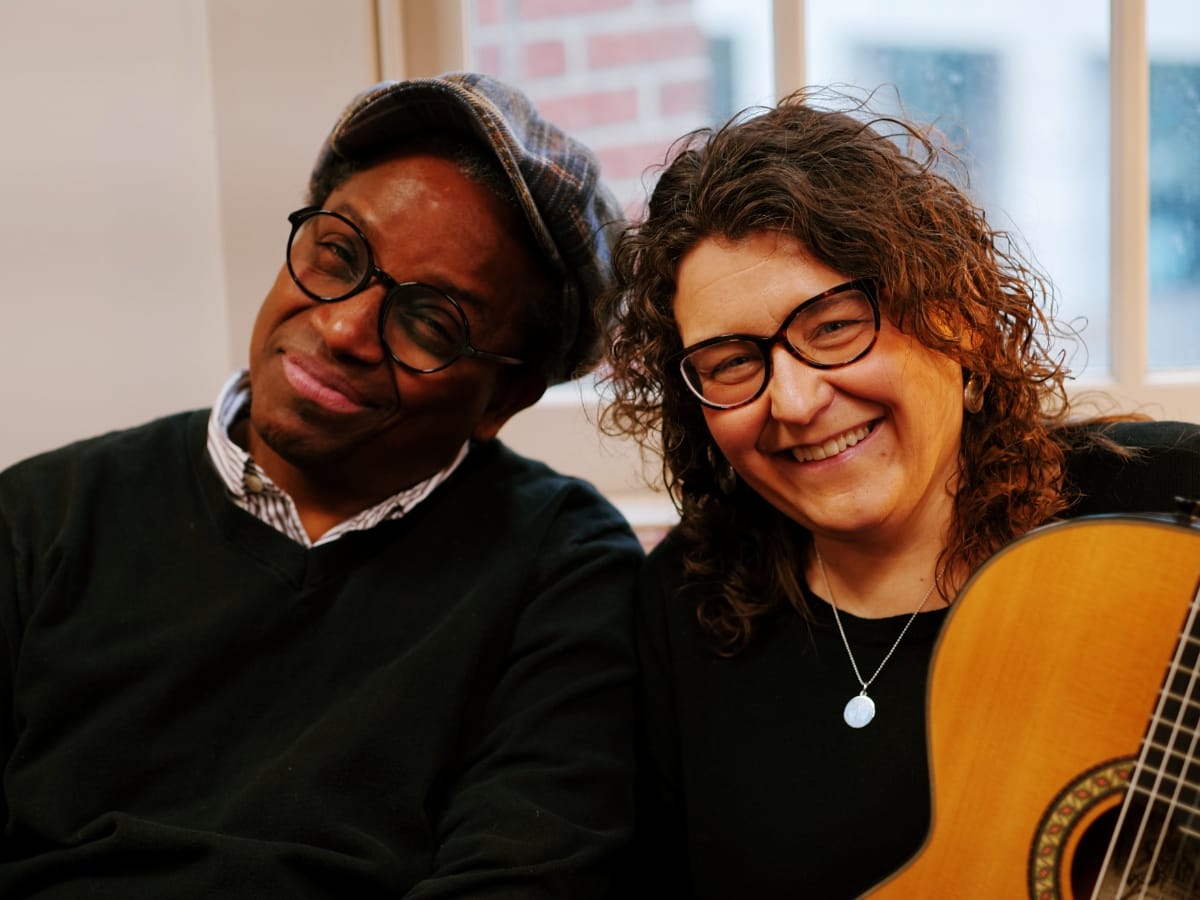
Lawrence: There’s this exciting moment over the last, let's call it a decade or so, of modern classical and improvisational music coming together, and artists from different traditions coming together. I'm curious about the negotiation of that. Many people were discouraged from improvising at conservatories, or told that certain kinds of music were not places they should go. Do you relate to that at all?
Kim: I think that there's a lot there in what you said. What strikes me the most is that in the instances where I feel like I am branching out from where I started, it's more like I met a person who I felt like I connected with about what music is and what music does. I think there are two aspects. There's what it is to you and what it does. In the case of both of my duos, and what you hear in this record with Mela, is that we were aligned in both ways. Music is powerful in our lives beyond the style, the genre, or the notes. I think that we identify with that right away without talking about it.
And then in terms of what it is and how it could work together, inside or outside of a genre, it's less bounded for us. It's more about sound, texture, form, and the bigger questions, rather than a stylistic boundary that would keep something out. It also didn't feel like we had to layer, "Okay, you're in a style and I'm in a style and we're going to do them at the same time." It was more like, "I have this and you have this other thing, and how do we work together? How do we play together?" So I think the value system matched, even if musically the thing seemed very different. If some of those fundamental values are the same and shared, then there's a lot of room to play.
In this music, it's more about the "what music does" that becomes the driver, and then you can put whatever other stuff in there; you could try different things and see what works. And so I think, from what I understand of my friends who are modern improvisers, that's where it's a lot the same as modern classical music in a way. In modern classical music, you come with textures, an idea of form, tone, phrasing, and a gestural approach to things. You have all this repertoire that informs your instincts. When you come to modern improvisation, you have a whole other set of techniques, approaches, your chops, and all the things that come from playing a variety of different jazz styles or popular styles or both. You're kind of building an aggregate form.
With Mela, because he is a percussionist, we're talking more about rhythmic structures. But if a person plays a harmonic or melodic instrument, are you okay with understanding that someone might call this an Aeolian mode, and someone else may call it an extended harmony, like a B-flat seven with a flat nine or something? Can you change your language?
Lawrence: It's intriguing to hear you return to this idea of values sharing. Something that feels maybe adjacent to that is the way the natural world is an inspiration, at least for this set of compositions and improvisations. The leap I would make there is finding the value in the natural world as an inspiration, as a sort of spiritual collaborator. If you'll stay in that philosophical zone with me for a moment, I'm curious how you translate the physical environment into the music. It seems to transcend song titles.
Kim: I think the other component for me is that I'm a visual artist as well.
Lawrence: Oh, okay. That makes sense.
Kim: I've always been interested in what a color or place might sound like. I think, as a person who came to composition much later than performance, it's helpful because instead of finding other music and saying, "Is it like this or not like this?" I’m putting other things to music. For example, in "Lake," there's this beautiful thing that happens in August where the clouds sit on the water, and it's all misty. The sun comes out, the mist comes up. So it's like, "Okay. What does that sound like? What kind of harmony would it be? What would you have to do with your hands to get it to work?"
So that idea of kind of stacking intervals, unconventionally, and then brushing the strings really fast in what they call rasgueado in classical music, and the speed at which you do it and the pitch level at which you do it, the register—that to me sounded like what I was looking at.
Similarly, I would take these little videos when something was beautiful, like light dancing as the wind picks up. What would that sound like? And so then I would try different things, and then you think, "Okay, and is there kind of a rhythm behind it? It's kind of timed. It's not really timed, but it feels like it." If you look at it long enough, you're like, "Oh, there is," and then there are these white cranes that live out there where I was. They would swoop through with super elegance. Well, that's like another theme. What would that sound like?
I'm constantly asking myself that: What would this sound like? Then you try something, and it takes on a life of its own. And then past that, I would think, "Okay, what structures could I use?" And then that's where some stylistic influences came in, in terms of how you’re going to create the form past these ideas, that type of thing.
Lawrence: In terms of where you compose, do you go to a room, or is there a compositional studio at Berklee? It seems like you would be highly attuned or sensitive to your surroundings based on the way you're talking.
Kim: No, you're totally right. What I'm trying to do is have different places. So this office is pretty good because I've got a window that looks out to a wetland system. I also have a nice room at my house, and then there's a lake cottage that our family has that's seasonal. So I did a lot of writing out there when I could be out there.
The thing is, I have a lot of small notebooks that are staff paper and stuff like that. The other thing that really helps me is that I just have the phone. If I’m taking a walk or something is happening in front of me, I take videos and photos of things. That way, it doesn't really matter where I am, as long as I'm somewhere quiet. I have the reference, and I'm like, "Oh, what is that?"
Lawrence: Tell me about the spiritual dimension to your music, whether it's this album in particular or more generally. Some of the quotes in the press material around the album talked about a sort of presence, being in the moment, things of that nature.
Kim: I think that's always been a part of my guitar playing because, as a kid, I came from piano. One of the things I realized about the piano pretty early on was that everyone can hear you practice. With the guitar, that's not necessarily true. You can sit wherever you want, and it can be a more intimate personal experience. I was very drawn to that. The whole time playing, that aspect of having a spiritual connection beyond myself and to something bigger has been part of my relationship with music, and particularly the guitar. So that's absolutely true.
I think there is a meditative experience that happens for me when I play and when I'm writing. That's part of the idea of the natural world being such a big inspiration. There's a connection there for me with that as well.
That's very true. I feel that the idea of being in the moment and being present with yourself and others is becoming harder and harder to do. We're in a very distracted world, and many of my students have grown up in a distracted environment, one that’s very tech-heavy. I think it's good to have a musical instrument in your life, where you're connected to something you're doing with your hands. Producing sound with your hands can be very grounding when the world around you is crazy.
If I can get into that mindset for myself, and then I can have a friend I’m playing with get into that mindset, then that connection also becomes part of that meditative experience. It doesn't feel like I'm competing or I'm worried about what he's going to think of what I'm playing or what other people are going to think of it. We're just communicating and we're creating something together, building something. That's important for me to have in my life, and a beautiful thing to have with someone else.
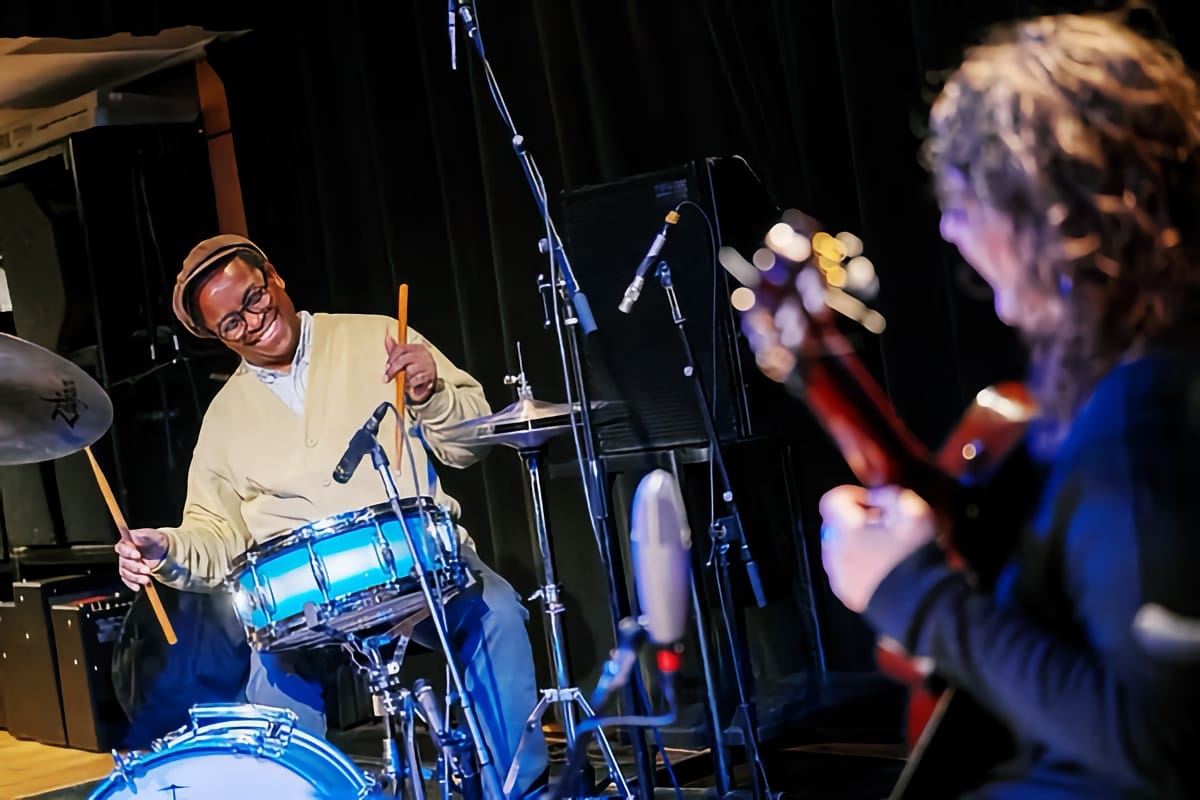
Francisco Mela and Kim Perlak performing in concert. Photos by Bryan Lasky.
I think it's hard for students. It's hard for all of us because if you're trying to have a positive and generative experience, you're afraid it'll be judged or you'll be judged. All the things that you're worried about in your life can come into that, and being able to sort of just keep that aside for a moment and have a connection with yourself is not easy to do. You also have to keep asking yourself as you're practicing, "Who am I and what do I sound like?" Everyone wants to have a voice, and everyone wants to have a sound.
Often, I'll ask a younger musician, "Describe your sound to me. Describe your tone." And they don't want to. They say, "Well, I don’t have one yet"—they're already judging it, or they're afraid it's not good enough. When you think about it, if you can't find a way to just let yourself really think about who you are and what you sound like, it's going to be a lot harder to develop that.
So like, why not? Even when I teach adult beginners, the hardest thing to do isn't to get them to make a list of the things they don't think are working. The hardest thing to do is to get them to make a list of what is good in their playing. We're trying to get rid of good and bad and replace this with familiar and unfamiliar, or what you want to hear and what you want to hear more of. Maybe that's just a perception. Maybe with every generation, we all think it gets worse. But I think it's a truth that we live in a distracted time where judgment is rewarded.
Lawrence: It's striking to me how difficult it must be for a young person, especially a developing artist in any field, who is engaged at all in social media. If you want to try to put yourself out there and be vulnerable and share your work in progress, you have to be pretty thick-skinned these days.
Kim: I think it’s good to know a lot of the negativity isn't about you. If it's coming to you, it's about the person who's saying the things and whatever that means for them. Hopefully, you can get to a point where you wish them the best. As long as you're safe, you just keep doing what you're doing. But I don't think anyone escapes from that part of our culture now. It just becomes like, who are we going to be in that moment? And then, who are we going to be moving forward?
I just want to believe that if you focus on positive things and build strong personal connections and relationships, they will ultimately grow over time. It’s like, what is real and what is not real? What is a tool to help you make some connections? And then what is your real musical life? I think those are big questions now in a way that they weren't before.
Check out more like this:
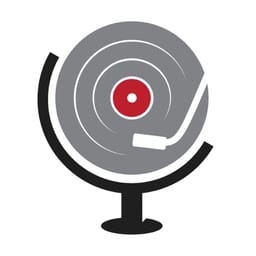 The TonearmLawrence Peryer
The TonearmLawrence Peryer
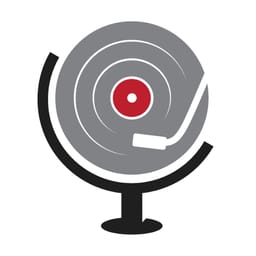 The TonearmLawrence Peryer
The TonearmLawrence Peryer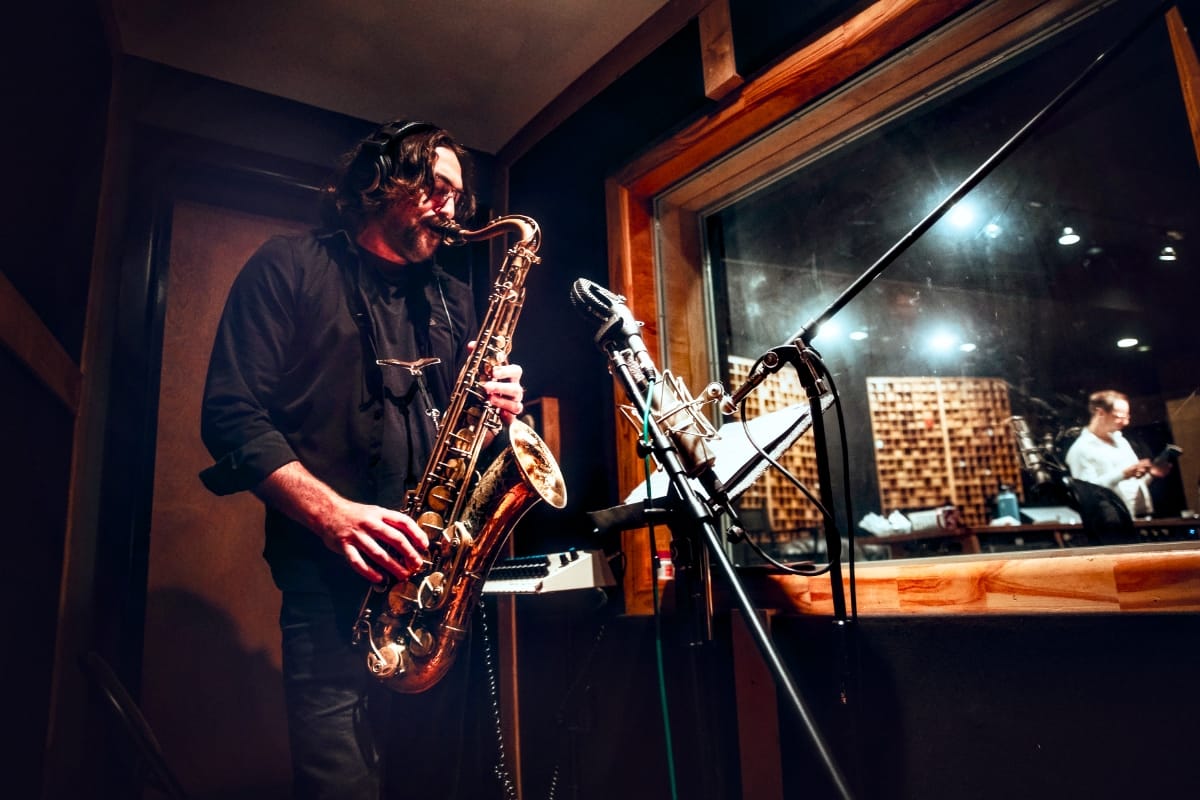


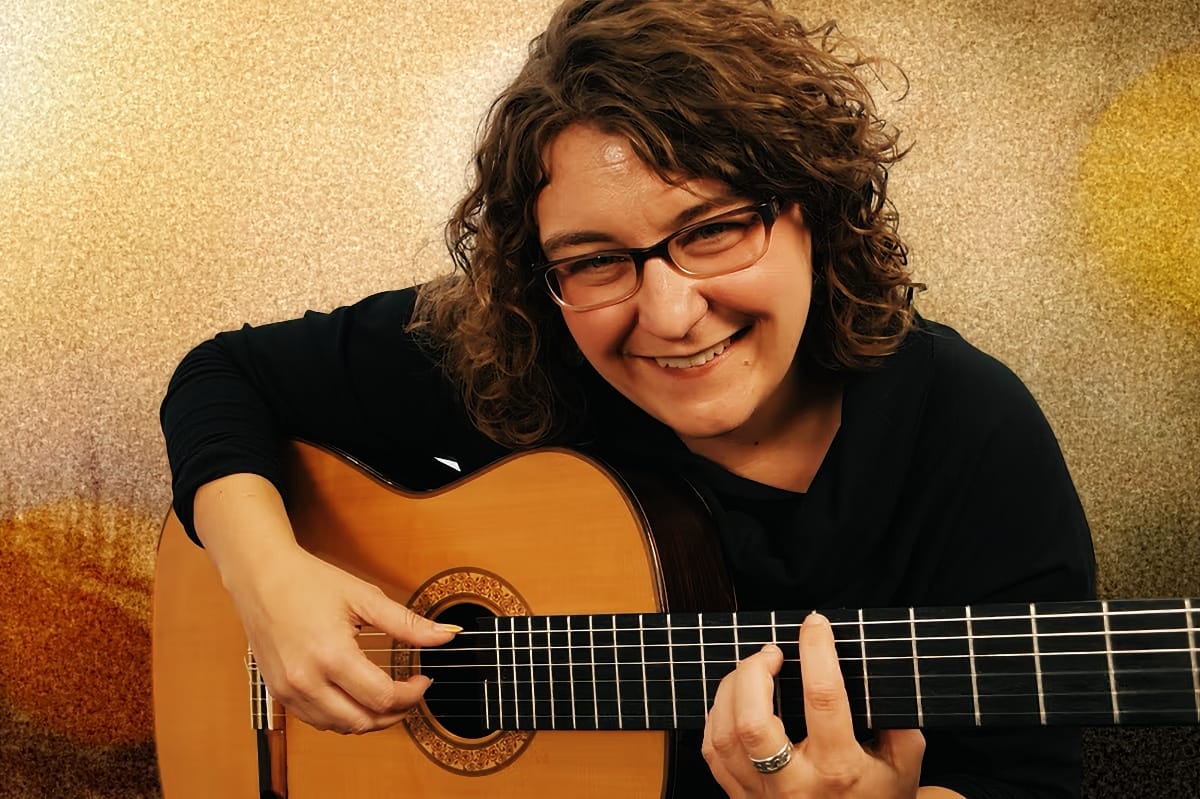
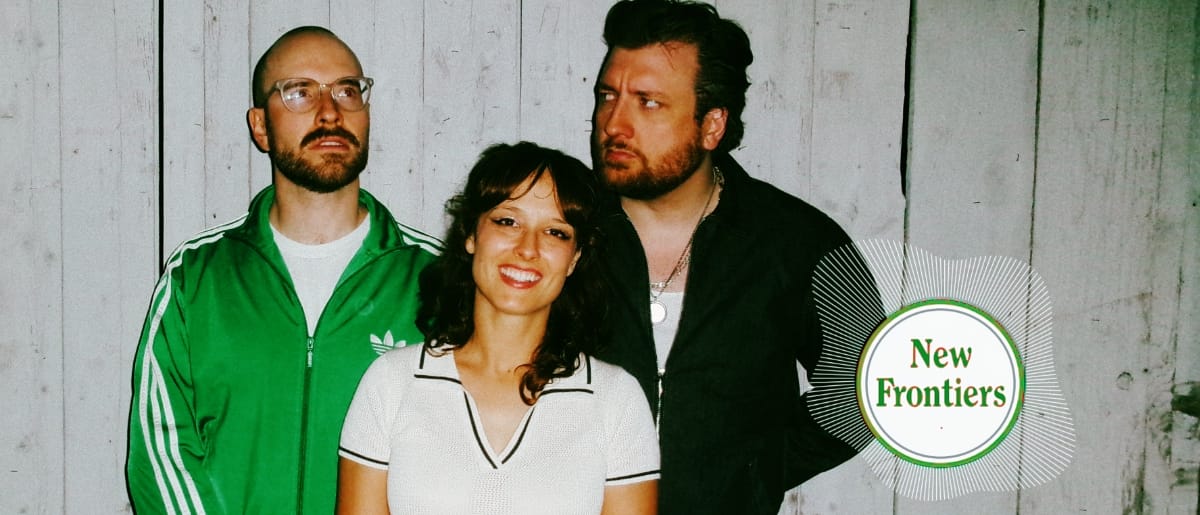


Comments